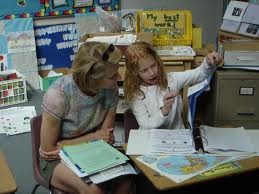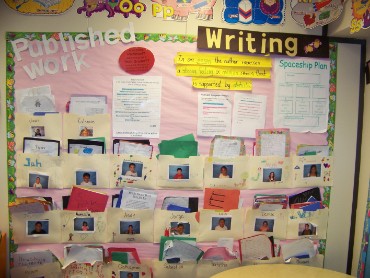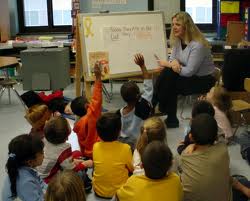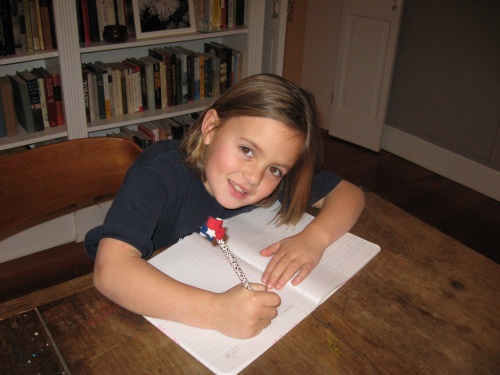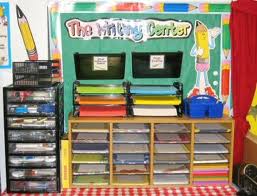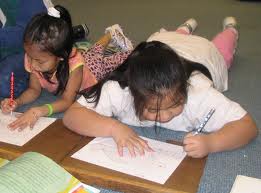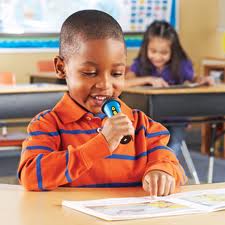Writing |
Reading and Writing: Reciprocal Processes Reading and writing are reciprocal processes, which means "one area can be used to strengthen and expand the other" (Fountas & Pinnell, 2009). Children develop these literacy skills in similar ways. According to Morrow (2009), "when reading and writing, children engage in similar activities. Readers and writers:
According to Fountas and Pinnell (2009), there are several common requirements of reading and writing involving processing behaviors including:
|
|
|
Process Writing The process approach to writing helps "children realize that writing involves thinking, organizing, and rewriting before a piece is complete" (Morrow, 2009). This differs from the writing workshop in that it expects students to carry each piece of writing through the entire process. It is a step-by-step process that is less flexible in nature than the workshop model. However, when used with particular students, it can serve as a valuable tool to guide students through writing development. According to Kuder and Hasit (2002), "by focusing on writing as a process, teachers can segment and provide support for children as necessary. The process writing approach can be effective for diverse learners." Process Writing: The Steps
See reference page: Morrow (2009), Kuder and Hasit (2002) |
Suggested Lessons for Improving Writing
|
Independent Writing Providing students with exposure to a variety of genres, allowing them choice of content, the ability to write at their developmental level in a safe environment
|
Differentiating Writing Instruction for Diverse Learners English Language Learners According to Peregoy and Boyle (2005), research suggests that the learning processes for first language and second language writing are similar, such that "children writing in a second language often support their efforts with drawings, just as their first language counterparts do". Additionally, the problems that writers generally encounter deal with generating a topic, word choice, spelling, grammar, or expanding ideas. These are challenges that both native English speakers and ELLs face. If the ELL is literate in their native language, many of the strategies used in their first language will potentially support their development of written English. Peregoy and Boyle (2005) found the process writing approach to be beneficial for many ELLs. The process approach used as a tool in the flexible setting of writer's workshop provide an ELLs with opportunities to generate ideas by conversing with their peers, enhancing personal relationships and allowing the to draw from personal experiences. Focusing on the process "frees English learners on their ideas first and focus on corrections last" (Peregoy and Boyle, 2005). Also, carrying their writing through publishing allows ELLs sufficient time to perfect a piece of writing which will likely boost their confidence and motivate them to continue writing. Fitzgerald and Amendum, providing or encouraging ELLs to select a topic that is authentic and personally relevant is essential. As with all writers, students write best when they write about what they know. Whether connecting to prior knowledge and experiences or a familiar text, their knowledge of the topic and the related vocabulary will support their attempts at written communication.
Students with Learning Differences and Gifted Learners As in every classroom, the range of learning styles and abilities amongst students is perverse. The favored format for writing instruction, the writer's workshop, lends itself very well to meeting the needs of every student. According to Romeo (2008), "the assessment of all learners, especially those that struggle with writing, is viewed as a daily, continuous, collaborative inquiry process that is intertwined with instruction, teacher/student self-regulation, and goal setting." The structure of the writing block is consistent, as it provides a mini-lesson (driven by assessment of student needs), time for independent writing (which allows for teachers to instruct and confer in small groups or individually with students, and time to share writing). This is an ideal environment for differentiating instruction to meet the needs of all students. Conferring with the teacher makes students more aware of their strengths as writers and what the areas they need to work on. Then, mini-lessons in a variety of settings (whole group or small group) allow teachers to instruct students on the areas of need. This provides opportunities for modeling and guided practice, where teachers can scaffold students based on need.
|
Writing Links - GAMES, ACTIVITIES, AND PRINTABLES! Click on the link for writing games where students can create their own comics, build their own stories, start their own journals, and MORE!PINKY DINKY DOO: http://www.pinkydinkydoo.com/printomatic.html Click on the link to find printables for creating newspapers, stationery, and books. PLUS, students can select from a variety of colorable characters, backgrounds, and other FUN STUFF! Suggested Articles for Further Research on Writing Instruction
Fitzgerald, J. and Amendum, S. (2007). What is sound writing instruction for multilingual learners? In S. Graham, C. MacArthur, & J. Fitgerald (Eds.), Best Practices in writing instruction (pp. 289-307). New York: Guilford Press. Romeo, L. (2008). Informal writing assessment linked to instruction: A continuous process for teachers, students, and parents. Reading and writing quarterly, 24: 25-51.
Tompkins, G. E. (2004). Understanding the essential characteristics of the writing workshop. Teaching writing (pp. 1-15). Upper River Saddle, NJ: Pearson. |








